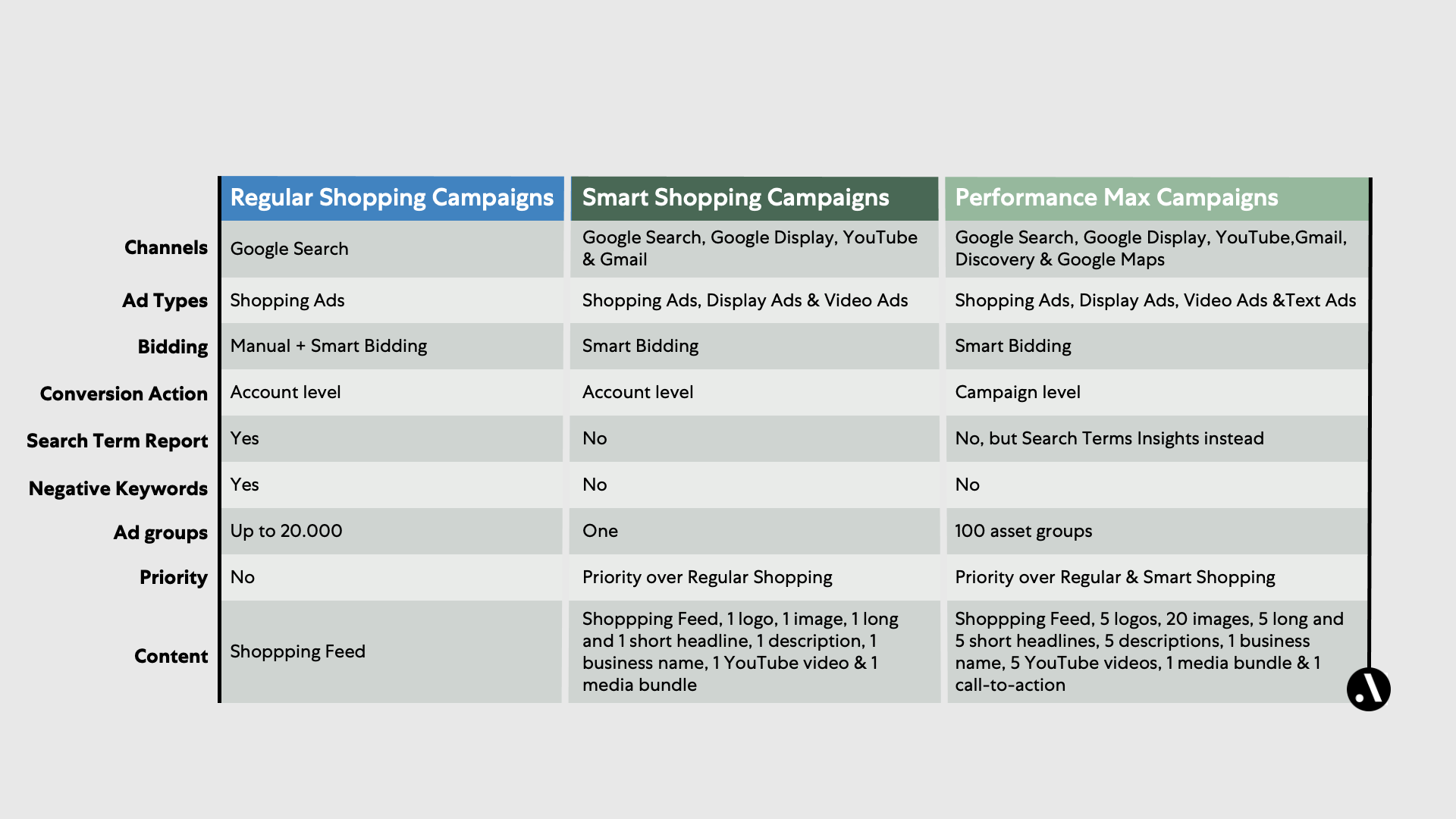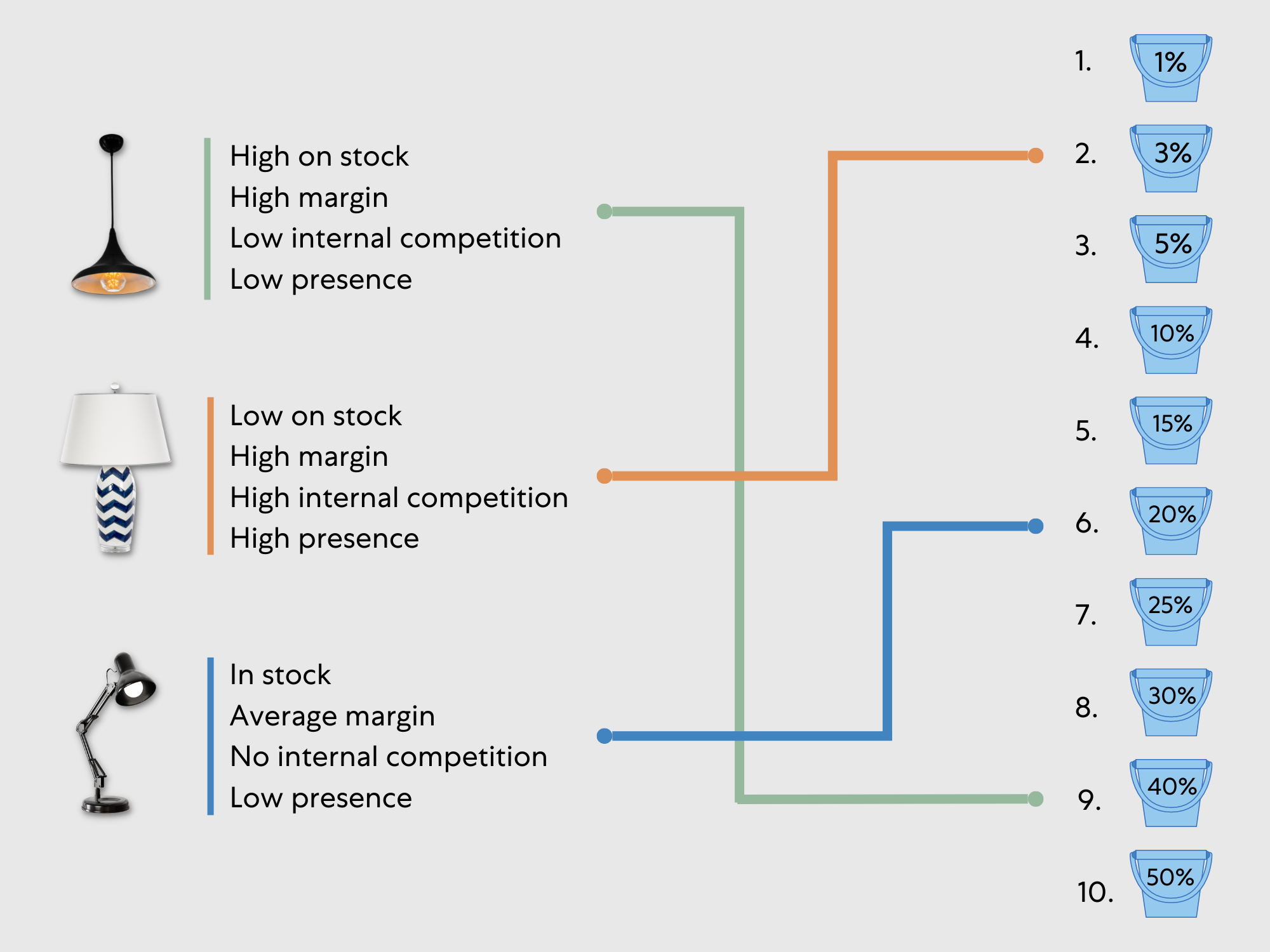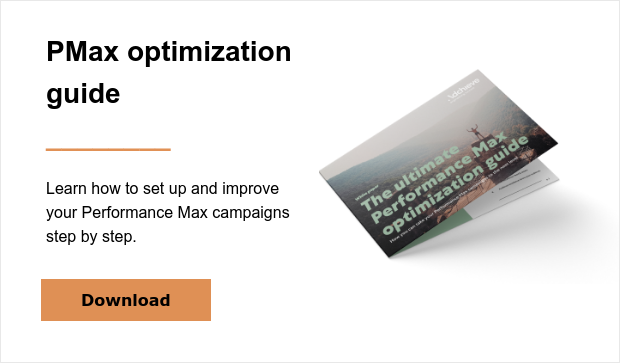In 2020, Google started rolling out the new campaign form. In the past, as a marketer you could have a lot of influence on the placements, bids and targeting of your campaign. Now, Performance Max automates all these options. In our last article, you read what this new campaign form involves and how best to optimize it. This time, we go deeper into the structure and construction of Performance Max campaigns. Where do you still have influence? And how do you set up your campaigns so that you get the most out of them? Read more below.
All about the Performance Max campaign structure
The Performance Max campaign structure resembles that of Smart Shopping. For example, you can choose similar bid strategies, like target-ROAS and target-CPA, and you can arrange campaigns based on location targeting or a specific budget.
However, there are several differences between the two. The first is that with Smart Shopping, you were shown in the Google Display Network with a limited choice in content. With PMax, you can be shown over all channels, and you have a wider collection of creative assets which you can use.
Smart Shopping also gave you the opportunity to bid more to win new customers. With Performance Max, you can target the entire campaign at new customers. By working with other creative expressions, you can therefore be much more relevant for your new target group. Click on the table to enlarge
Click on the table to enlarge
Finally, a Smart Shopping campaign could be structured in ad groups. In Performance Max campaigns, these have been replaced by asset groups. Such a group consists of a collection of content on a theme or related to a target group. Google uses this content to make ads and build up a collection for all applicable ad formats for the objective of the ad. An asset from a group can be combined with another asset from the group. For each campaign, you also place more groups in an asset group structure to group content per theme or for specific targeting.
Compared with Classic and Smart Shopping campaigns, you have a much wider choice of creative assets in Performance Max. In terms of creativity, there is therefore greater potential within the campaigns and structure of PMax.
How do you structure PMax campaigns?
Three factors are important to determine the best structure for your Performance Max campaigns:
1. Business strategy
2. Profit below the line
3. At least 30 conversions a month
Business strategy
Firstly, your campaign structure depends on what you want to achieve with your business and your campaigns. The best structure for Performance Max follows the strategy and the objective of the business. This might be optimizing profit, turnover or optimal stock management. Depending on your choice, you then organize the campaigns.
Profit margin
The most important reason for dividing the product feed into several campaigns is because you have a different objective for certain products or a different budget. The profit margin, so how much profit a product generates, can vary. And budgets and objectives can only be set at campaign level, so you want to respond optimally.
At Adchieve, we look at the profit of the order following the click on a product ad. Say someone clicks on product A. The purchase can then be product B or twice product A. We therefore want to know how much we earn from a product ad, also considering factors like purchase price, shipping costs and any returns.
With that in mind, we estimate the margins at product level. We can use that to then create a structure, so that you have an expected profit margin per product. We place similar profit margins together in product groups, also called buckets. There may be two, or even ten. That depends on the extent to which you can and are willing to divide your products. If you have lots of different margins, you might have ten buckets. But if your product assortment consists of thousands of products, and if the margins do not vary much from each other, you might choose one, two or three buckets. You can then place a higher or lower target on those buckets and bid more aggressively or more conservatively.
Minimum of 30 conversions per month
The number of buckets you use for the campaign not only depends on the difference in profit margin, but also on the conversion volume in the bucket. You want to prevent a campaign generating too few conversions, because you won't then achieve the results you wanted. To be able to generate sufficient data to let the automatic bid strategies do their work, we generally say that at least 30 conversions, or purchases, must take place a month. Only then can you divide up a campaign. If you don't have that, you'd be better only using one campaign.
Product Bidding
Besides targeting margin, you also want to consider other factors when organizing your products in different campaigns. For example: the stock situation of a product, the visibility of a product and the extent of internal competition. We call this Product Bidding.
Are there some products that haven't received any clicks during a certain period? In that case, we advise you to set up a 'zombie campaign'. This extra campaign is intended to give products another chance of being shown on the Google results page. You implement this campaign by adding a custom label with a specific value, for example 'zombie', to the SKUs. In this way, you can later filter within your Google Ads campaigns. If the product receives a click, with the right automation it can then move to another campaign. You can use this strategy with the bucket strategy described above.
Another example is responding to the stock availability of a product. Based on the turnover rate, you can predict when the stock of a product is running low. If this looks likely, you will want to bid less or not at all. You can obviously save yourself a lot of money if you don't advertise on products that will sell out anyway.
As a final example, you can also use the internal competition if you advertise with several labels or via marketplaces on the same search words. If there is a lot of internal competition, you might choose to bid less aggressively for a certain product.
For the best structure, your strategy, profit margins and number of conversions are therefore important. With these three factors, you can determine the best campaign structure within Performance Max. But make sure that you advertise on all products which are important, and that you give your products a filter to incorporate them in your campaigns. Also ensure that your budgets are not limited if you want to advertise on the ROAS target. And finally, provide a useful naming convention, so that the structure is clear for yourself and any colleagues if they go into your account.
Interested to know which account structure you can best use for Performance Max? In this article, find out all about the Burger Structure?
Asset group structure
In addition to organizing your campaigns, it is important to organize asset groups to ensure you get the most out of Performance Max. Dividing up asset groups has certain advantages and disadvantages.
Advantages of dividing up
Campaigns are best organized according to different budgets and objectives, while asset groups are best organized according to theme. This is done to increase the relevance of the ad. And you can improve the relevance of your ad by creating more relevant asset groups.
This is because you will be able to specify particular texts, images and videos per theme, so that your ad can target a particular user at a given time. This increases the CTR and your ad’s conversion rate and lowers your CPC, and therefore improves your returns on the Performance Max campaign.
Disadvantages of dividing up
The disadvantage of dividing up asset groups is that, without the right tooling, it involves more work creating and maintaining them. Also, the number of clicks is distributed across multiple asset groups, which means that Google has less data available to test the most effective combination of assets. Google can also compile texts based on the content on the landing page and your GMC. It is therefore not always necessary to create asset groups at the product level.
In most cases, however, it is advisable to subdivide asset groups and there is an optimum that depends on the increased relevance on the one hand and the workload and data fragmentation on the other.
Asset group types:
In total, we can distinguish five types of asset groups:
1. Generic asset group (all products);
2. Asset groups based on main categories of your website;
3. Asset groups based on target groups;
4. Promotion asset group;
5. Dynamic asset groups based on search and/or revenue volume.
1. Generic asset group
A generic asset group is a group that contains all your products. You can therefore only include generic texts and images. The generic asset group may be your only asset group, but you can also combine it with other asset groups where it functions as a safety net to ensure all products are advertised.
2. Asset groups based on main categories of your website
You can create a simple first subdivision of your Performance Max campaign by following the main categories of your website. The website is divided into different themes for a reason and it often makes sense to follow this subdivision with PMax. Also, your product feed is often divided in this way, making it easy to select the right products within a single asset group.
The advantage of this method is that you only need to set up and maintain a limited number of asset groups. The disadvantage is that you fail to achieve maximum relevance because you can often identify other subgroups that might have made your ads even more relevant.
3. Asset groups based on target group
Another approach is to divide asset groups based on the target group. You then get separate asset groups, for instance, based on a teenager, a young woman, an older couple, etc. This can then be reflected in the choice of images, the videos, the USPs and in the communication method.
This works especially well for webshops where there is a clear distinction in the needs and experiences between the different target groups. We see this especially in the Fashion and Home & Living segment.
4. Promotion asset group
In addition to asset groups based on themes, you can also add a promotion asset group. This is an asset group that is only active during a specific promotion, such as Black Friday. With promotion asset groups you communicate your website’s ongoing promotions to persuade people to buy more. By communicating the limited time frame of the promotion, you will create urgency and increase the likelihood that consumers will make a purchase. The advantage of creating a separate asset group is that the data of the other asset groups remains unchanged. You also only need to modify a single asset group instead of all of them.
5. Dynamic asset groups
An important constraint with Performance Max is that you can only create 100 asset groups per campaign. The potential number of asset groups is often much bigger, especially when you see all the brands, categories, combinations of these, and individual products as a potential asset group. So, you will need to prioritize.
One way to prioritize asset groups is to look at sales volumes. Which brands, product categories, combinations of these, or individual products are sold most? The higher the sales, the higher the priority and the more reason to create a separate asset group for that specific brand, product category, combination or individual product.
Other approaches for determining the importance of asset groups are search volumes per theme or the size of target groups that you can link to assets.
In the event that 100 asset groups are not enough, you can create extra sets of bid buckets with different ROAS settings and different products. Each bid bucket within an extra set contains the same asset groups which deviate from your previous set or sets of bid buckets.
Did you know?
With Adchieve you can easily create different asset groups automatically based on your product feed. You can make texts as relevant as possible by using the columns from the product feed. The software links images from the asset library to the right asset group.
You can also easily load videos dynamically per asset group. Adchieve has developed an algorithm specifically for dynamic asset groups that determines the most optimal asset group set based on your sales data. This enables you to create highly relevant ads for your target group while minimizing the time spent in setting up and maintaining the Performance Max campaigns.
The influence of the structure on profitability
As mentioned, your campaign structure directly influences your profitability. The better you set up your strategy, the better your structure is and the more you can get out of your Performance Max campaigns.
But what about your existing campaign structure for Search? We still advise using the Hagakure structure. With Performance Max too, this structure offers the most success. Because Google likes collecting and combining as much data as possible, so that algorithms can operate more easily.
You might even choose to add extra search words to your search campaigns according to the Hagakure method, so that this gets priority in the PMax campaign. Particularly when a search term matches exactly, the campaign will get priority, regardless of the match type. If you haven't given your search word, PMax will take over. This also happens if that ad ranks higher. The bid is then tighter or the ad quality better. Which is great, because you spend less for a certain position and click than if the ad quality was lower. .png?width=889&height=600&name=Campaign%20structures%20-%20pros-cons%20Table%20(4).png)
Click on the table to enlarge
5 best practices for your Google PMax campaign structure
Overall, there are five best practices which you can use to set up the optimal Google Performance Max campaign structure:
1. Ensure the right account structure: earlier we discussed the Burger Structure for your account. Combine those insights with the priorities and tips from this article for the ideal account and campaign structure.
2. Structure your asset groups: organize them as smartly as possible with clear themes, content and text.
3. Set target groups: these are still important. Make sure that your remarketing target groups, customer match and customer segment are set properly, and that you then link them to the right asset groups.
4. Structure in buckets: as describe above, the bucket structure is certainly one of our best practices for Performance Max. It helps you influence your business results and it's easy to achieve with the campaign settings of PMax.
5. Ensure at least 30 conversions: automatic bid strategies always work best if they can target large volumes of data. Our general rule is that a campaign must generate at least 30 purchases to be effective. In this way, algorithms can do their work and target the right factors for the best result.
In this way, you determine the best campaign structure for Performance Max.
This article talked in detail about the campaign structure of Performance Max campaigns and how you can optimally organize them for maximum profitability. To summarize, three factors are important for the success of your campaigns: business strategy, maximum value below the line and minimum 30 conversions per campaign.
If you combine these three factors with our five best practices, you have all the ingredients for the best campaign structure in Performance Max.
Want to learn more about Performance Max?
Download for free the detailed Performance Max white paper in which you will find all the information you need for successful campaigns.

.jpg)


